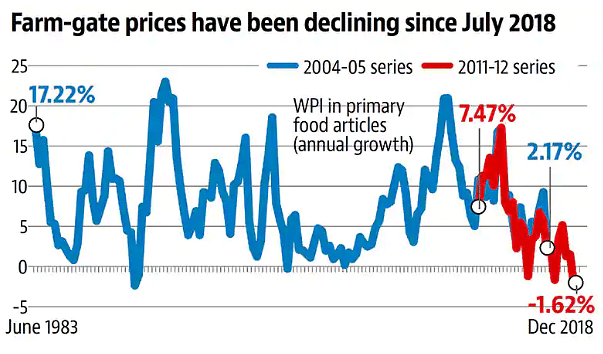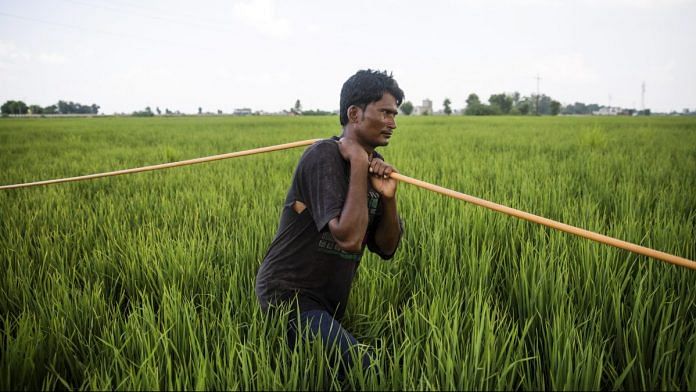WPI sub-component for primary food articles has been negative for six consecutive months beginning July 2018.
New Delhi: This financial year, 2018-19 could end up being the worst year for farm incomes in almost two decades, government data indicates in a revelation that emphasises the gravity of the ongoing agrarian crisis and highlights a possible fault line for the Bharatiya Janata Party (BJP)-led National Democratic Alliance (NDA) government ahead of the Lok Sabha elections.
According to Wholesale Price Index (WPI) data for the month of December released on Monday by the ministry of commerce and industry, the WPI sub-component for primary food articles has been negative for six consecutive months beginning July 2018. This means their prices are falling.
WPI for primary food articles is a good indicator of farm-gate prices as farmers sell their products in wholesale rather than retail markets. Even the food sub-component of the Consumer Price Index (CPI) basket has registered negative growth between October and December 2018. The disinflation in wholesale prices is not visible in the non-farm economy though. The overall WPI has shown positive growth in all these months.
Analysts say the asymmetry in inflation – falling farm-gate prices and rising non-farm prices – means that farmers have suffered deterioration in their terms of trade. They are selling their products cheaper, but having to buy other things at higher prices.
The WPI sub-component for food components was -0.1% in December. It was -2.1%, -4%, -0.2%, -1.4% and -3.3% in the preceding five months. The last time WPI for primary food articles showed negative annual growth for two consecutive quarters was in 1990. The disinflation in farm prices has also led to a collapse in nominal farm incomes, which was last seen in 2000-01.
Doubling farm incomes was one of biggest promises of the Narendra Modi government after it assumed office in 2014. It was repeated during a resolution on agriculture adopted by the BJP at its recent national council meeting in New Delhi. The resolution says: “Budget allocation for the agriculture sector has also increased in recent years and this government is fast reaching towards the goal of ‘doubling the farm income’. This National Council expresses its confidence that the aim of ‘doubling the farm-income’ would be achieved in given time period under the BJP government.”
The agrarian crisis is one of the factors that may have resulted in the BJP’s loss in three Hindi heartland states of Chhattisgarh, Rajasthan and Madhya Pradesh in December, according to analysts, and the party clearly doesn’t want it to affect its prospects in the 2019 parliamentary elections. HT reported on December 29, 2018 that the government is considering a farm package that could include farm loan waiver, direct income support to farmers, crop insurance at a flat premium of Rs 1, and Rs 2,000 per acre transfer to farmers to make up for post-harvest losses.
“The crisis of price growth in agriculture is a political economy problem. The present government has been trying to appease rating agencies and middle class at the cost of domestic economy and farmers by low inflation through keeping food prices depressed,” said Himanshu, an associate professor of economics at the Jawaharlal Nehru University. “A hike in kharif MSPs did not help, because there is also a problem of demand deflation in the rural economy. Collapse in rural wage growth has eroded purchasing power and demand, which cannot be addressed by farm loan waivers and MSP hikes,” he added.
Along with their adverse distributional impact on farmers, disinflation in food prices will also have a macro impact on the Indian economy. Fall in nominal rural incomes due to falling prices and low rural wage growth, are bound to put a squeeze on consumption demand in the economy. At a time when consumption growth is already decelerating, this will have an adverse impact on overall growth figures as well, said Niranjan Rajadyaksha, research director and senior fellow at IDFC Institute, Mumbai.
“The disinflation in food prices shows that terms of trade have worsened for agriculture. This also underlines the fact that the crisis in the rural economy is of incomes and not wealth. The government thinks that it can address the rural crisis by aiding wealth creation by promoting construction of houses and toilets. This is not going to work and it is also too late for the government to address the crisis in farm incomes,” said Praveen Chakravarty, chairman of the Congress data analytics department.
The BJP offered a different view. “Falling inflation is always a welcome sign, as it is pro-poor. But rising inflation does not always mean that the farmers are getting a good price for produce, because of inefficiency and gaps in supply chain. Falling inflation will also help the Reserve Bank of India cut down interest rates and catalyse faster growth,” said BJP spokesperson Gopal Agarwal.
Also read: Heavy debts alone are not driving farmers to suicide
To be sure, the current crisis in farming is related more to a crash in farm prices rather than output growth.
In July, 2018, the government increased the minimum support prices (MSPs) of 14 crops to give farmers a 50% return over their cost of production.
According to quarterly WPI data from June 1983 onwards from the Centre for Monitoring Indian Economy’s (CMIE) database, the last time WPI for primary food articles showed negative annual growth for two consecutive quarters was in December 1989 and March 1990. This analysis has used both the 2004-05 and 2011-12 series of WPI.

That disinflation in farm-gate pries has put a squeeze on farm incomes can be seen from a comparison of growth in agricultural GDP at current and constant prices. The first advanced estimates of GDP figures for 2018-19, which were released by the Central Statistical Office (CSO) last week, show that the difference between current and constant price growth in Gross Value Added (GVA) in agriculture and allied activities was -0.1 percentage point. This differential is 4.8 percentage points for overall GVA. While constant price incomes are a useful way to make long-term comparisons, a collapse in current price income in one sector is bound to impose significant hardships on incomes and consumption of those employed there.
A comparison of agricultural growth figures for both the 2011-12 and 2004-05 GDP series shows that such a collapse in current price growth in agriculture has not happened since 2000-01.

To be sure, the first advanced estimates are based on only about two quarters of actual economic data, and can change at a latter stage. This also means that if the present trend of disinflation in farm-gate prices continues, nominal agricultural income growth could fall even more.
These statistics are particularly disturbing for the government, as they have come in the wake of the highest hikes in Minimum Support Prices (MSPs) since 2014. MSP for paddy, the most important Kharif crop, was increased by 12.9% for the 2018-19 cropping season compared to a growth of 3.7%-5.4% between 2014-15 and 2017-18. The failure of MSP hikes to arrest the decline in farm-gate prices was taken note of by RBI as well. “The prices of several food items are at unusually low levels and there is a risk of sudden reversal, especially of volatile perishable items. Secondly, available data suggest that the effect of revision in minimum support prices (MSPs) announced in July on prices has been subdued so far,” the RBI monetary policy committee held between December 3-8, 2018, noted in its minutes.
Recent WPI statistics also question the received wisdom of middlemen being the cause of low farm-gate prices, as WPI growth for manufactured-food items has also been in negative territory in September and December quarters.
A silver lining for the government in these numbers is that depressed food prices have kept overall inflation under control. Food items have a more than 40% weight in the overall Consumer Price Index (CPI) basket.
Also read: Modi govt to announce income support scheme for farmers before Union Budget
By special arrangement with ![]()







ther real reason is improper logistics arrangements to export the excess agri and to get higher prices in export market or to find alternate crops/ induystries for farmers